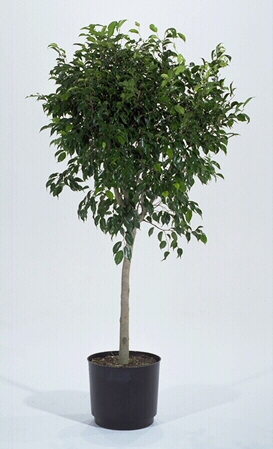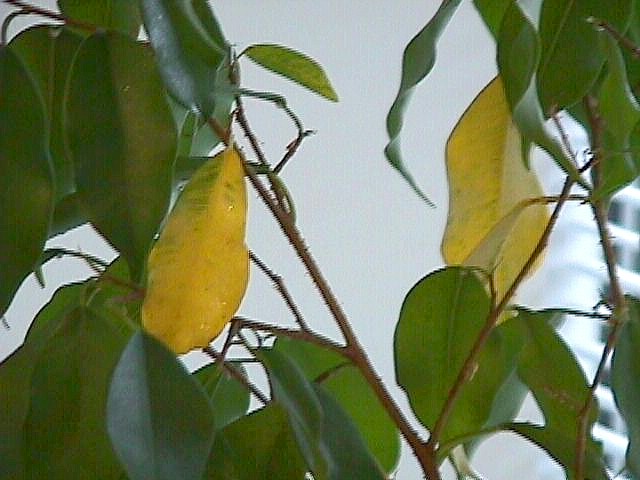Plant Tips
First of all, it is ideal and easiest to maintain a Ficus tree in a high light area, (direct light 4 to 6 hours per day). Ficus trees will lose its leaves due to stress commonly caused by these conditions: (a) adapting to a new environment, (b) over/under watering and (c) parasitic insects. It is normal and to be expected for a Ficus tree to lose 20% of its foliage as it adapts to a new environment. This period can be very trying, since it will look like the tree loses its leaves no matter what you do. The rule of thumb on watering is
more light present, the more water required by the tree, in this case but it applies to all
indoor plants. The reverse also applies, less light then less water. It will
always be critical that you check the soil for moisture to determine if water is needed.
(check the FAQ on The picture to the right illustrates yellow leaves on the
Ficus tree. If the damaged leaves (yellow or green) do not fall when the tree is shaken, then the cause could be parasitic insects. The most common are; mealy bug, red spider and scale. The detection and treatment of will be covered in the following months. If you are unsure, take a sample of some leaves to reputable nursery and ask. They can then recommend a treatment if necessary. A discussion on treatment of bugs/parasites on plants can be read in FAQ section on dealing with bugs. Once the tree is stable and growing it will require minimal care (a weekly check of the soil for moisture content and watering if needed). It can provide a very attractive addition to you home or office. As the tree grows it may require shaping and pruning, typically every 4 to 6 months depending on its speed of growth. After all, we don't want our Ficus trees to look like a bad hair day. A discussion on pruning is covered in the FAQ section on pruning. In summary, it is estimated that 95% of the care and maintenance of Ficus trees is having them in adequate light and proper amounts of water. A well maintained Ficus tree can be a stunning addition to your home or office for many years. Should you have any questions about your Ficus trees that this did not cover, please E-Mail us.
|
|
| Your Plant Service. All rights reserved. Revised: January 21, 2007 |
 We
receive the most questions on the care and maintenance of Ficus Trees. Frequently people will shy away from using this
tree because of the bad press that its received; (always drops leaves, can not keep one
alive, can not move a Ficus tree, etc.). There is a perception that this is a difficult
plant to maintain indoors. The plan is to dispel some of the myths and misinformation about
this plant and hopefully let you see that it can be an option in your office or home.
We
receive the most questions on the care and maintenance of Ficus Trees. Frequently people will shy away from using this
tree because of the bad press that its received; (always drops leaves, can not keep one
alive, can not move a Ficus tree, etc.). There is a perception that this is a difficult
plant to maintain indoors. The plan is to dispel some of the myths and misinformation about
this plant and hopefully let you see that it can be an option in your office or home. The tree could also be dropping leaves colored yellow,
green or a combination of the two. This is nothing more than an indication that the tree
is in stress. The stress is commonly due to over or under watering though as stated above
other factors could be the cause. Once the cause is diagnosed and the correction is
applied, expect the tree to continue to drop leaves for a few weeks as it recovers.
The tree could also be dropping leaves colored yellow,
green or a combination of the two. This is nothing more than an indication that the tree
is in stress. The stress is commonly due to over or under watering though as stated above
other factors could be the cause. Once the cause is diagnosed and the correction is
applied, expect the tree to continue to drop leaves for a few weeks as it recovers.